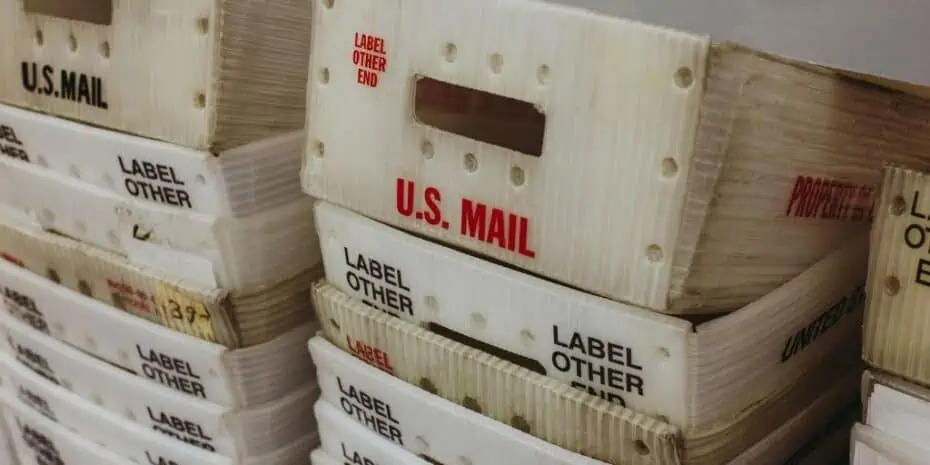What Is Direct Mail?
REtipster features products and services we think you’ll find useful. If you buy something featured here, we may earn an affiliate commission. Your support helps us continue this work! Learn more.
Direct mail or direct mail marketing is a common way for businesses to reach potential buyers (or sellers, in the case of real estate investing).

Some real estate investors prefer direct mail as their marketing medium because it is a time-efficient way to contact thousands of prospects in the hope of finding a deal that could result in a high return on investment[1]. Real estate investors who use direct mail often use a combination of postcards, flyers, or even handwritten letters to express their interest in buying properties that recipients own[2].
Most direct mail marketers will send out thousands of letters or postcards at a time. Due to the size of these mail campaigns, they will use a property owner data service (like DataTree, PropStream, or ListSource) to compile specific lists of property owners and a mailing service (like Rocket Print, ITI Direct Mail, or Click2Mail) to print and send the mail.
A direct mail campaign aims to get qualified leads (the recipients of the letter) to contact the sender. To do so, they often design their direct mail with attention-grabbing elements such as large images and headlines or enclose special offers in the envelope. They also include contact details to let the recipient know how to respond[4].
How often an investor sends direct mail depends on the type of offer, the demographic of the area, and the occasion. For example, some investors send more direct mail during holidays[5] while others will intentionally avoid sending mail during the holiday season.
BY THE NUMBERS: Open rates for direct mail can reach as high as 90%, compared to 20 to 30% for emails.
Source: Smallbizgenius.net
RELATED: How I Find Motivated Sellers (And Get Them Calling Me)
Direct Mail Types and Examples
The investor can use certain types of direct mail, depending on their audience, or combine various kinds as they wish.
However, here are the most common types of direct mail that businesses and investors often use[6]:
Postcards
Postcards are a very common type of mail piece because this type of mail requires less paper, less ink, and cheaper postage. They also don’t require the recipient to open an envelope to see the message, which eliminates a barrier to delivering their message to the recipient. All the investor has to do is to provide the message they want to include on the postcard.
In general, postcards also take the least time and expense. A postcard can cost anywhere between 50 cents to $1[7], making them a staple of small businesses trying to promote its services. Postcards can also showcase properties, highlight a business and its services, or promote special offers and services.
Handwritten Letters
Handwritten letters tend to be more personal and casual. They offer a perceived personal and emotional connection with the sender. The sender can also choose the handwritten route if they are confident with their handwriting or if they can use a handwritten font that looks authentic.
Senders can write the letters themselves or get the help of mailing houses to print the letter. These letters may also come with reply cards or order forms.
One real estate example of a handwritten letter is a “yellow letter,” which is traditionally written on a piece of a legal pad and stuffed into an envelope. These days, yellow letter services on the internet can approximate the real thing.
Neutral Letters
Neutral letters are so-called because they only inform the recipient that the sender is interested in purchasing their property. This usually offers nothing else other than the sender’s contact information with a request for the recipient to call back or respond in some way.
A neutral letter gives the investor greater control over how much they can offer on the property, but only after the lead has responded and contacted them. Neutral letters also give the investor some opportunity to build rapport with the lead, giving them additional insight into the offer.
At the same time, neutral letters often lack specificity and require the marketer to spend additional time corresponding with the recipient. This procedure aims to qualify the recipient and determine whether or not they can do business together.
Blind Offers
In real estate, a blind offer is a type of direct mail where the investor sends a purchase offer for a property as their first mail piece. This type of mail can be somewhat tricky and time-consuming because the investor has to determine the value of the target property beforehand, then base their offer on that value. It is also bulkier because the sender has to attach a blank purchase agreement in each piece of mail, which means it can cost significantly more than sending a postcard.
Blind offers are highly efficient and scalable in real estate, but it turns off certain property owners who think their property is worth more than the sender offers. However, once a “template” for a blind offer is made, the sender only needs to change some details, such as the recipient, the property, and the offer, to send it to other recipients.
Typed Letters
Typed letters are more professional-looking compared to handwritten ones. This type of direct mail marketing may also feature the real estate firm’s logo and photos of the property and the owner.
However, typed ones are more often perceived as impersonal and “mass-produced,” which often leads to recipients discarding them because they do not consider typed letters written appropriately for their situation.
Flyers
Real estate flyers typically promote open houses, house tours, current listings, and upcoming sales. These direct marketing campaigns usually include bold headlines, strong graphics, and a description of why the property stands out.
Brochures
Brochures or catalogs provide easy access to information about current listings. These brochures highlight details like the description, photos, and price of a specific property. Brochures can also promote multiple properties.
Newsletters
A real estate newsletter is a type of direct mail sent out regularly to past and potential buyers or sellers to engage them about relevant topics. Likewise, investors send out newsletters to their sphere of influence to share content regularly and keep their names on their prospects’ “top of mind.”
BY THE NUMBERS: The average return on investment for direct mail is 29%.
Source: Neilpatel.com
What Are the Advantages of Direct Mail?
In an age where everything is digital, the physicality and visceral appeal of direct mail can make it stand out. Direct mail can also enhance digital-only marketing campaigns as a supplement, instead of replacing them (like online or email marketing campaigns).
Here are more specific benefits of direct mail marketing:
It saves time and resources.
Direct mail is an affordable and fast way to reach out to potential clients and new leads. Senders can keep costs at a bare minimum by doing things themselves or working with a reliable printing company. Bulk mailing direct mail is also faster and cheaper than other alternatives[8].
It builds awareness and local connections.
Direct mail helps businesses show prospective customers that they understand the local market. Direct mailers can send resources that match the prospect’s needs and offer custom solutions that address specific problems. It builds a personal connection that grabs the recipients’ attention[9].
It is also an easy means to reach large numbers of recipients. People generally stay in one home for years or they maintain their old P.O. boxes even when they move, unlike email addresses that can be changed on a whim.
It is tangible and longer-lasting.
Visually appealing print materials and engaging content enable people to remember a brand. Plus, recipients can easily share direct mail marketing materials with their families and friends.
Compared to email or digital ads, direct mail marketing commands more attention and holds it for far longer. Plus, physical materials take up actual space, unlike email stored in the ether, giving it a persistent, more significant impact on purchasing decisions[10].
It complements digital marketing campaigns.
Businesses and investors use traditional and online marketing campaigns to raise awareness and boost engagement. Direct mail is an offline tool that can encourage readers to interact with the brand online. For example, leads and prospects can get a URL or QR code from a direct mail letter to connect to a website[11].
Takeaways
- Direct mail is a traditional form of marketing that involves physical correspondence with customers. It usually contains promos, offers, and other material that encourage the recipient to respond to the sender.
- Investors and marketers use direct mail because it has a higher response rate and higher ROI potential than other forms of marketing, such as email marketing.
- In real estate, investors use either neutral letters (informing the recipient that they want to purchase the property) or blind offers (directly offering a certain amount for the property). However, they can use any type of direct mail most suited to their audience.
Sources
- Velt, T. (2020.) Why Direct Marketing Works for Real Estate. Real Trends. Retrieved from https://www.realtrends.com/why-direct-marketing-works-for-real-estate/
- Real Estate Skills. (2020.) Direct Mail: The (Ultimate) Guide. Retrieved from https://www.realestateskills.com/blog/direct-mail
- Reonomy. (2020.) The Guide to Direct Mail for Commercial Real Estate. Retrieved from https://www.reonomy.com/blog/post/how-real-estate-professionals-can-utilize-direct-mail
- Brumer, L. (2019.) How to Use Direct Mail Campaigns to Find Investment Properties. Millionacres. Retrieved from https://www.millionacres.com/real-estate-investing/articles/how-use-direct-mail-campaigns-find-investment-properties/
- ProspectsPLUS.com. (n.d.) Pull The Trigger! How Often Should You Send Direct mail. Retrieved from https://news.prospectsplus.com/how-often-should-i-send-direct-mail/
- King, G. (2020.) 5 Proven Direct Mail Marketing Ideas for Real Estate Agents in 2021. ReminderMedia. Retrieved from https://remindermedia.com/blog/5-proven-direct-mail-marketing-ideas-for-real-estate-agents-in-2021/
- Wise Pelican. (2021.) How Much Does It Cost To Send Real Estate Postcards? Retrieved from https://www.wisepelican.com/how-much-does-it-cost-to-send-real-estate-postcards/
- WeMailAmerica.com. (2021.) Benefits of Mail Marketing For Real Estate Investors. Retrieved from https://wemailamerica.com/benefits-of-mail-marketing-for-real-estate-investors/
- Mburugu, C. (2020.) Real Estate Direct Mail Marketing Tips For Success. Mashvisor. Retrieved from https://www.mashvisor.com/blog/real-estate-direct-mail-marketing/
- Esajian, J. (n.d.) Improve Your Real Estate Direct Mail Campaign. Fortune Builders. Retrieved from https://www.fortunebuilders.com/direct-mail-campaign-for-motivated-seller-leads/
- Lizarraga, M. (n.d.) Why You Should Have a Real Estate Direct Mail Marketing Campaign. AgentFire. Retrieved from https://agentfire.com/direct-mail-marketing-benefits/






